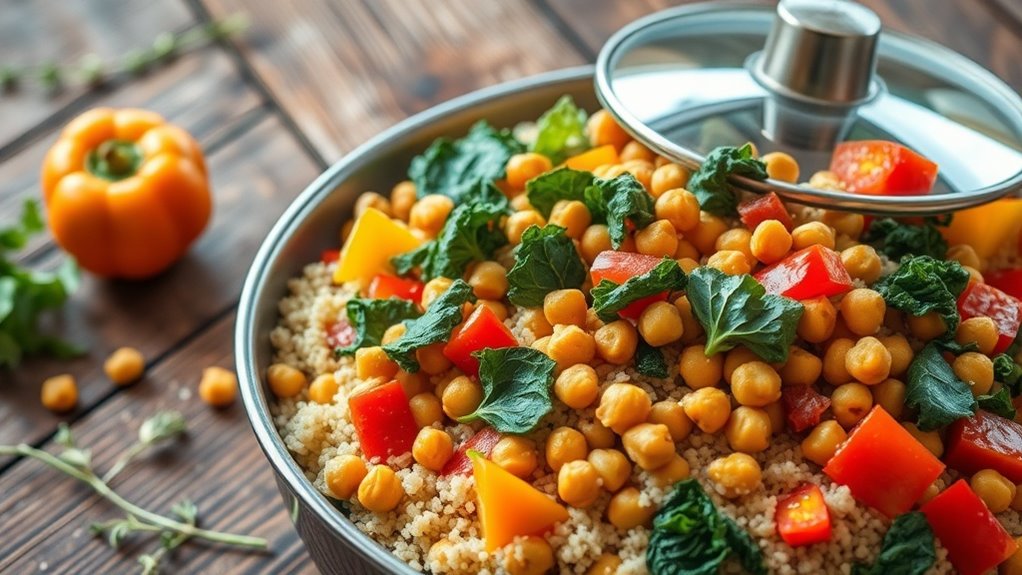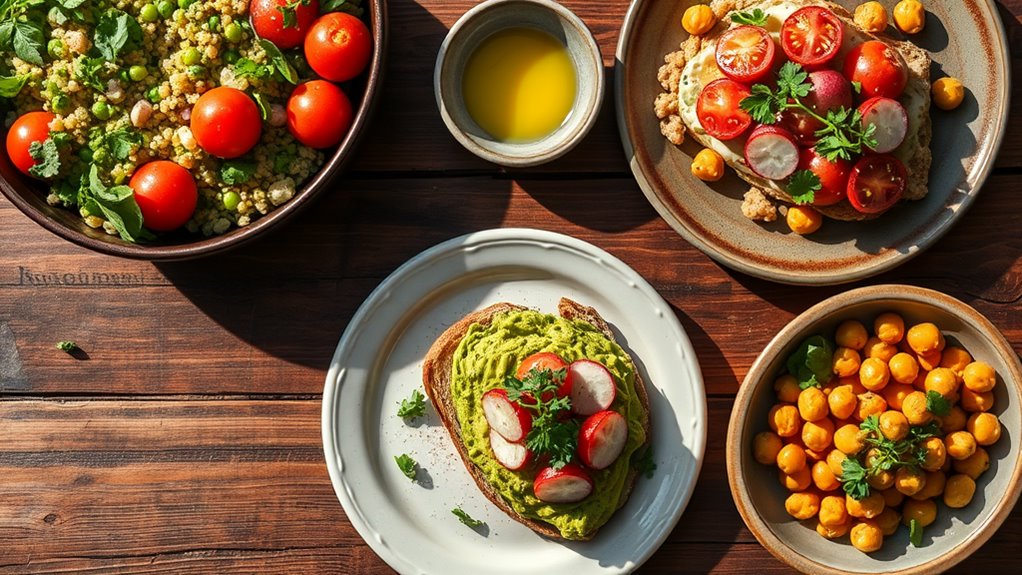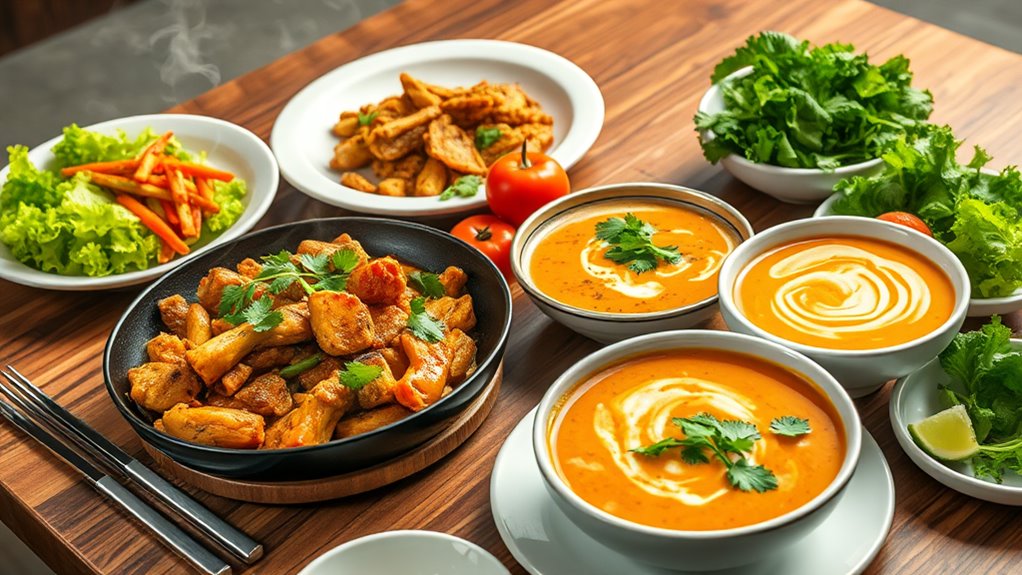Elevate Your Weeknight Meals to Gourmet With Ease!
To elevate your weeknight meals to gourmet status with ease, start by upgrading your pantry essentials. Stock high-quality oils, vinegars, and artisanal grains for a flavor boost. Master basic cooking techniques like searing and emulsification to enhance your dishes. Focus on creating balanced plates with vibrant veggies and protein, and use stylish plating for visual appeal. Embrace seasonal ingredients for maximum freshness. There’s so much more about transforming your cooking with simple changes waiting for you!
Key Takeaways
- Upgrade your pantry with high-quality oils, vinegars, and spice blends for enhanced flavors in everyday meals.
- Utilize seasonal vegetables for freshness and nutrition, making dishes both vibrant and flavorful.
- Master simple cooking techniques like deglazing and emulsification to create gourmet sauces quickly.
- Focus on plating by balancing colors and textures for an appealing presentation that elevates any meal.
- Enhance your dining experience with precise beverage pairings that complement the flavors of your dishes.
Upgrade Your Pantry Essentials
When you’re ready to elevate your weeknight meals, upgrading your pantry essentials is a game changer. Start by stocking high-quality oils and vinegars; they’ll transform basic dishes into culinary delights. Spice blends bring powerful flavors and can instantly switch up your meal’s vibe. Don’t forget gourmet salts—these little treasures enhance each bite with depth and sophistication. Replace ordinary pasta with artisanal varieties, and explore innovative grains like farro or quinoa. Nuts, seeds, and high-quality canned goods are also essential; they offer convenience while adding texture and nutrition. Additionally, incorporating gourmet dinner ideas can inspire you to create meals that impress with impressive flavors and elegant presentations. With these essentials, you’ll navigate meal prep with gourmet ease, leaving your guests—or family—impressed. It’s time to open up your pantry to new possibilities and redefine what’s for dinner.
Choosing High-Quality Ingredients
Upgrading your pantry opens the door to how you select ingredients for your meals. Prioritize freshness and seasonality when sourcing produce, as they not only enhance taste but also promote nutritional value.
Seek out local farmers’ markets or specialty grocers where you can discover vibrant, high-quality ingredients. When it comes to proteins, favor grass-fed, free-range, or sustainably caught options, which deliver superior flavor and ethical assurance.
Don’t overlook your pantry staples; choose extra virgin olive oil, aged balsamic vinegar, and artisan salts to elevate even the simplest dishes. Additionally, focusing on restaurant-quality flavors can make even basic ingredients shine.
Finally, taste and smell ingredients before purchasing—trust your senses. By carefully selecting high-quality ingredients, you’ll lay a solid foundation for creating gourmet weeknight meals that impress.
Mastering Flavor Profiles
To elevate your weeknight meals, mastering flavor profiles is key.
You’ll learn to understand basic flavor elements, balance sweet and savory notes, and layer aromatics for depth.
With these skills, your dishes won’t only taste fantastic but also keep everyone coming back for more.
Understanding Basic Flavor Elements
Although many home cooks focus primarily on recipes, understanding basic flavor elements can transform your weeknight meals into culinary delights.
Start by getting to know the five foundational tastes: sweet, sour, salty, bitter, and umami. Each of these elements plays a significant role in creating depth and balance in your dishes.
For instance, incorporating acidic ingredients like citrus or vinegar enhances flavors and cuts through richness. Use herbs and spices to elevate your meals, bringing in warmth and dimension.
Don’t forget about texture—crunchy elements can contrast beautifully with tender components.
When you grasp these basics, you’ll be able to intuitively adjust and build flavors, making each dish a masterpiece that excites the palate and impresses diners.
Balancing Sweet and Savory
When you master the art of balancing sweet and savory, you’ll reveal a new level of flavor in your weeknight meals.
Begin by choosing ingredients that naturally embody both profiles, like caramelized onions or roasted sweet potatoes. Incorporate a touch of honey, maple syrup, or balsamic glaze to enhance savory dishes without overpowering them.
Conversely, a sprinkle of sea salt can elevate sweet treats, providing that enticing contrast. Don’t shy away from using herbs like thyme or rosemary; they can bridge the gap between these flavors beautifully.
Experiment with sauces and dressings that blend sweet and savory, and always taste as you go. With practice, you’ll create harmonious dishes that excite your palate and impress your guests effortlessly.
Layering Aromatics for Depth
Layering aromatics in your cooking not only builds depth but also transforms simple dishes into flavor-packed experiences. Start with a base, like onions or garlic, then build complexity through herbs and spices. As you sauté aromatics, their essential oils release, infusing your dish with richness. Incorporate ingredients in stages to amplify their flavors.
| Layer | Aromatic Example |
|---|---|
| Base | Onion |
| Mid-Layer | Garlic |
| Herbs | Thyme or Rosemary |
| Spices | Cumin or Paprika |
| Finish | Fresh Cilantro or Basil |
Simple Cooking Techniques for Gourmet Results
To elevate your weeknight meals without spending hours in the kitchen, mastering a few simple cooking techniques can make all the difference.
Start with proper knife skills; a well-chopped onion or finely minced garlic can enhance flavors and presentation.
Embrace the art of searing; browning proteins builds a rich, savory crust that elevates any dish.
Experiment with deglazing; after sautéing, splash in a bit of wine or stock to create a luscious sauce.
Don’t overlook the power of seasoning; balance your flavors by tasting as you cook and adjusting accordingly.
Finally, practice emulsification; blending oil into vinegar or citrus creates a velvety dressing that transforms salads.
Additionally, using quick and tasty dinner recipes can help you create these gourmet meals in no time.
These techniques won’t only impress but also make gourmet cooking second nature.
Creating a Balanced Plate
Mastering simple cooking techniques not only enhances flavors but also sets the stage for creating a balanced plate.
Start by visualizing your plate as a composition of colors, textures, and nutrients. Aim for half of your plate to be filled with vibrant vegetables, providing essential vitamins and fiber.
Next, incorporate a complex carbohydrate, like quinoa or brown rice, to offer sustained energy. Don’t forget your protein – whether it’s lean meat, fish, or plant-based options, it should take up roughly a quarter of your plate.
Finally, consider healthy fats, such as avocados or olive oil, to enhance absorption of nutrients. Including wholesome lunch ideas can also help you stay on track with fueling your body with essential nutrients throughout the day.
Elevating Your Proteins
Elevate your proteins by experimenting with marinades and cooking methods that bring out their best flavors. Instead of going for the usual grill or bake, consider sous vide techniques for precision cooking or a quick sear for rich caramelization.
A lemon-garlic marinade can brighten chicken, while a balsamic reduction can enhance beef’s depth. Don’t overlook the power of brining; it keeps poultry juicy and flavorful.
Try using your broiler to achieve a crispy finish that’s reminiscent of gourmet cuisine. Always let your proteins rest after cooking; this allows juices to redistribute, ensuring tenderness. Including tasty high-protein meals in your repertoire can further enhance energy and nutrition.
Master these techniques, and you’ll transform even the simplest ingredients into elevated weeknight meals that impress and satisfy. Your culinary prowess will shine.
Fresh Herbs and Spices: The Secret Weapons
Fresh herbs and spices can transform your weeknight meals into something extraordinary.
Understanding herb flavor profiles and knowing how to pair spices can elevate every dish you create.
Plus, you’ll want to know when to choose fresh herbs over dried for the best taste.
Herb Flavor Profiles
Herbs and spices are your secret weapons in the kitchen, capable of transforming ordinary meals into extraordinary experiences. Understanding herb flavor profiles is essential for achieving culinary mastery.
For instance, basil’s sweet, slightly peppery notes elevate Mediterranean dishes, while cilantro brings a fresh, citrusy twist to Latin cuisine. Dill offers a delicate anise-like flavor perfect for fish, while rosemary contributes a robust, woody essence to hearty meats.
Thyme’s earthy undertones complement many savory dishes, balancing flavors beautifully. Don’t overlook mint’s invigorating zing, ideal for both sweet and savory applications.
Spice Pairing Tips
Releasing the full potential of your meals often comes down to how well you understand and pair your spices and fresh herbs.
Start by recognizing the dominant flavors in your dish; then, select complementary spices to elevate those notes. For instance, if you’re using basil, try pairing it with garlic or lemon zest to enhance its freshness.
Experiment with smoky paprika alongside cumin in savory dishes, or let rosemary shine with roasted meats and root vegetables.
Don’t shy away from contrasting flavors; a pinch of cinnamon can beautifully balance a spicy chili.
Fresh vs. Dried Herbs
When you’re aiming to elevate your weeknight meals, choosing between fresh and dried herbs can make a significant difference in flavor.
Fresh herbs burst with vibrant oils and fragrant notes, enhancing dishes like salads, sauces, and roasted vegetables. Use them towards the end of cooking to preserve their bright essence.
On the other hand, dried herbs deliver concentrated flavor and convenience, making them perfect for longer cooking times in stews, marinades, or casseroles.
Remember, generally—one tablespoon of fresh equals one teaspoon of dried.
Experiment with both to discover how they transform your meals, and don’t shy away from combining them for a layered impact.
Mastering this balance can turn simple dishes into culinary masterpieces.
Gourmet Sauces Made Easy
Have you ever wondered how to transform a simple weeknight meal into something extraordinary? Gourmet sauces are your secret weapon.
Start with a classic base: sauté minced garlic and shallots in butter or olive oil. Deglaze the pan with white wine or broth, scraping up those flavorful bits.
Now, stir in cream or a splash of soy sauce for depth. Infuse your sauce with fresh herbs or a zesty squeeze of lemon to brighten it up.
For a punch of flavor, consider adding mustard, capers, or even a hint of chili. With just a few ingredients, you’re crafting a sauce that elevates grilled chicken, roasted vegetables, or pasta to gourmet status.
Master these techniques, and you’ll impress without the fuss!
Stylish Plating Tips
When it comes to presentation, color contrast can make your dishes pop and excite your guests.
Selecting the right plate size also plays an essential role in how your meal looks, enhancing the overall experience.
Plus, mastering garnishing techniques can elevate even the simplest meals into something truly special.
Color Contrast Matters
Though you might think taste is the only thing that matters, the visual appeal of your meals can greatly enhance the dining experience. Using color contrast is key to stylish plating. It draws the eye and elevates even the simplest dish.
Start by selecting ingredients with varying hues—vivid greens, rich reds, and bright yellows. For instance, pair sautéed spinach with roasted cherry tomatoes, and finish with a drizzle of bright balsamic reduction. This not only creates a feast for the eyes but also highlights the natural flavors.
Don’t forget garnishes; fresh herbs or edible flowers add vibrant pops. By mastering color contrast, you’ll transform weeknight meals into artistic culinary creations, making every dining occasion a celebration.
Plate Size Selection
Choosing the right plate size can make a significant difference in how your meals are presented. A larger plate showcases your dish with ample space, creating a sense of grandeur and elegance.
However, don’t overlook the power of smaller plates; they can enhance the perception of portion size and help emphasize intricate plating.
Consider the dish you’re serving—think about how it complements the plate’s design and size. For instance, a beautifully arranged pasta deserves a broad, shallow plate, while a refined protein with a sauce might shine on a slightly deeper dish that captures its essence.
Always aim for balance; your choice should elevate, not overwhelm. Mastery in plate selection transforms an ordinary meal into a crafted culinary experience.
Garnishing Techniques Explained
A beautifully plated meal goes beyond just the right plate size; garnishing techniques play a key role in elevating your culinary creations.
Start with an eye-catching element, like fresh herbs or edible flowers, placed strategically to add color and vibrancy. Use sauces or purees to create artful drizzles or dots, enhancing both flavor and aesthetics.
Remember, height adds drama—stack ingredients or use a mold to lift components. Textures matter too; sprinkle crunchy elements like toasted nuts to contrast softness.
Finally, don’t forget about symmetry and balance—align your garnishes for a polished look.
With these techniques, you’ll transform simple dishes into gourmet masterpieces that impress both visually and on the palate.
Happy plating!
Incorporating Seasonal Vegetables
As you plan your weeknight meals, incorporating seasonal vegetables not only boosts flavor but also enhances nutrition and supports local farmers.
Start by visiting your local farmers’ market or grocery store where seasonal produce is prominently displayed. Consider vibrant options like heirloom tomatoes in summer or hearty root vegetables in fall. By selecting vegetables at their peak freshness, you’ll notice richer flavors and improved textures in your dishes.
Experiment with various cooking methods, such as roasting to caramelize or steaming to retain nutrients. Toss seasonal vegetables into stir-fries or salads to elevate simple meals into gourmet experiences.
As you master this technique, you’ll not only enrich your plates but also develop a deeper appreciation for what each season brings to your table.
Quick and Elegant Side Dishes
While you might think side dishes require elaborate preparation, quick and elegant options can easily elevate your meals with minimal effort.
Consider sautéing asparagus with a sprinkle of lemon zest and a dash of sea salt for a vibrant addition. You can also whip up a creamy polenta, topped with freshly grated Parmesan, to bring a touch of sophistication.
Roasting garlic and tossing it with green beans adds depth and flavor, while a simple quinoa salad enriched with herbs and cherry tomatoes offers a revitalizing contrast.
Don’t overlook the power of microgreens; they can transform any plate into a work of art.
With these quick, yet refined side dishes, you’ll impress without the fuss, showcasing your culinary prowess.
Wine and Beverage Pairing for Weeknight Elegance
When you want to elevate a weeknight meal, choosing the right wine or beverage can make all the difference. Pairing expertly not only enhances flavors but also showcases your culinary flair.
Here are some suggestions to heighten your dining experience:
-
A crisp Sauvignon Blanc with herb-roasted chicken to brighten the dish.
-
A rich, velvety Merlot alongside a mushroom risotto that complements its earthy notes.
-
A rejuvenating Negroni for savory charcuterie, elevating your appetizer game.
-
A smooth, spiced chai tea to accompany your decadent chocolate dessert, creating a stunning finish.
Frequently Asked Questions
What Are Some Budget-Friendly Gourmet Meal Ideas?
For budget-friendly gourmet meals, try risotto with seasonal vegetables, herb-crusted chicken with roasted potatoes, or a chickpea curry served with basmati rice. You’ll impress everyone without breaking the bank while enjoying culinary mastery at home.
How Do I Store Leftover Gourmet Meals?
To store leftover gourmet meals, you’ll want airtight containers that seal in freshness, like Tupperware. Cool leftovers before refrigerating, and consume within three days to maintain that exquisite taste you’ve crafted. Don’t let it go to waste!
Can I Prepare Gourmet Meals in Advance?
Absolutely, you can prepare gourmet meals in advance! Focus on dishes that store well, like casseroles or sauces. Just make certain you reheat and assemble with care to preserve that restaurant-quality taste and presentation.
What Kitchen Tools Are Essential for Gourmet Cooking?
Think of your kitchen as an artist’s studio. Essential tools like sharp knives, a quality chef’s pan, precision scale, and sous vide machine will turn your culinary aspirations into masterpieces, elevating every dish you create with finesse.
Are There Quick Dessert Options to Pair With Gourmet Meals?
Yes, you can whip up quick desserts like rich chocolate mousse or zesty lemon sorbet. Both require minimal ingredients and time, yet they beautifully complement gourmet meals, leaving your guests impressed and satisfied while keeping it simple.





